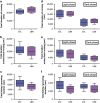Fragmentation and high entropy of neonatal experience predict adolescent emotional outcome
- PMID: 26731439
- PMCID: PMC5068874
- DOI: 10.1038/tp.2015.200
Fragmentation and high entropy of neonatal experience predict adolescent emotional outcome
Abstract
Vulnerability to emotional disorders including depression derives from interactions between genes and environment, especially during sensitive developmental periods. Across evolution, maternal care is a key source of environmental sensory signals to the developing brain, and a vast body of work has linked quantitative and qualitative aspects of maternal care to emotional outcome in children and animals. However, the fundamental properties of maternal signals, that promote advantageous vs pathological outcomes in the offspring, are unknown and have been a topic of intense study. We studied emotional outcomes of adolescent rats reared under routine or impoverished environments, and used mathematical approaches to analyze the nurturing behaviors of the dams. Unexpectedly, whereas the quantity and typical qualities of maternal care behaviors were indistinguishable in the two environments, their patterns and rhythms differed drastically and influenced emotional outcomes. Specifically, unpredictable, fragmented maternal care patterns translated into high-entropy rates of sensory signals to the offspring in the impoverished cages. During adolescence, these offspring had significant reductions in sucrose preference and in peer-play, two independent measures of the ability to experience pleasure. This adolescent anhedonia, often a harbinger of later depression, was not accompanied by measures of anxiety or helplessness. Dopaminergic pleasure circuits underlying anhedonia are engaged by predictable sequences of events, and predictable sensory signals during neonatal periods may be critical for their maturation. Conversely, unpredictability maternal-derived signals may disrupt these developmental processes, provoking anhedonia. In sum, high-entropy and fragmented patterns of maternal-derived sensory input to the developing brain predicts, and might promote, the development of anhedonia in rodents, with potential clinical implications.
Figures




References
-
- Caspi A, Sugden K, Moffitt TE, Taylor A, Craig IW, Harrington H et al. Influence of life stress on depression: moderation by a polymorphism in the 5-HTT gene. Science 2003; 301: 386–389. - PubMed
-
- Heim C, Binder EB. Current research trends in early life stress and depression: review of human studies on sensitive periods, gene-environment interactions, and epigenetics. Exp Neurol 2012; 233: 102–111. - PubMed
-
- NIMH Workgroup. Transformative Neurodevelopmental Research in Mental Illness—Report of the National Advisory Mental Health Council's Workgroup. Available at http://www.nimh.nih.gov/about/advisory-boards-and-groups/namhc/neurodeve....
Publication types
MeSH terms
Grants and funding
LinkOut - more resources
Full Text Sources
Other Literature Sources
Medical

